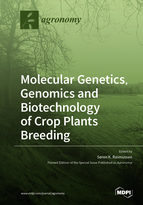Molecular Genetics, Genomics and Biotechnology of Crop Plants Breeding
A special issue of Agronomy (ISSN 2073-4395). This special issue belongs to the section "Crop Breeding and Genetics".
Deadline for manuscript submissions: closed (30 June 2019) | Viewed by 82084
Special Issue Editor
Interests: mutational breeding; genome-wide association studies; quality traits; grain crops; molecular plant breeding
Special Issues, Collections and Topics in MDPI journals
Special Issue Information
Dear Colleagues,
With genome sequences now available for the major crop plants, new possibilities have opened up for combining genotyping and phenotyping for crop improvements. Stronger statistical methods are being developed that allow to identify the underlying genes of quantitative traits. These methods also support gene discovery when genome-wide markers are combined with phenotyping of large breeding populations or collections. Additionally, strong statistical prediction methods and next generation sequencing, which has allows some of the original ideas that were challenged by biotechnology in crop plants to be revisited, and solutions that are more precise to be pursued.
It has been a wish to combine genetics and knowledge of plant nutrition, but the required precise phenotyping of a large number of plants from different environments and growth seasons is still a major challenge for improving nutrient use efficiency. With the introduction of DNA sequencing in the early 1980s, genetic transformation of important crop species, development of PCR-based methods for marker assisted selection, and next generation sequencing provided the easy development of markers for orphan crops.
Developing crops for food, feed, fuel, and fun, the last could include ornamentals; removing anti-nutritional factors or improving health properties of the harvested crop are other topics. We welcome papers on the above-mentioned topics and also reviews that look into experiences grained over the previous 35 years of molecular genetics and biotechnology in crop plants.
Prof. Søren Kjærsgaard RasmussenGuest Editor
Keywords
- Next generation sequencing
- Genotyping-by-sequencing
- Oligo-directed mutagenesis
- Crispr/cas9 mutagenesis
- Genome-wide association scan
- Rapid Cycle Crop Breeding
- Genetic modification






